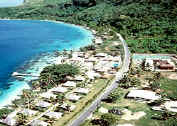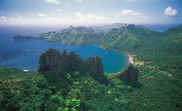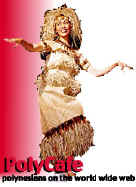





![]() Attractions
Attractions![]()
Tahiti
Papeete
has something of an image problem. French Polynesia's busy port
capital does have  heavy rush-hour traffic and ugly concrete developments, but it also
has a beautiful waterfront where yachts, ferries and cargo
boats come and go, and a thriving market full of South Pacific
atmosphere. There are abundant cafés, mobile snack vans and
eateries along this strip and it's a lovely place to mill about and
soak up the scene. Legacies of the region's maritime history are all
over the place and the ghosts of Bougainville and Cook have an
omnipresence along Papeete's coast.
heavy rush-hour traffic and ugly concrete developments, but it also
has a beautiful waterfront where yachts, ferries and cargo
boats come and go, and a thriving market full of South Pacific
atmosphere. There are abundant cafés, mobile snack vans and
eateries along this strip and it's a lovely place to mill about and
soak up the scene. Legacies of the region's maritime history are all
over the place and the ghosts of Bougainville and Cook have an
omnipresence along Papeete's coast.
The market, Marché du Papeete, is a colourful and vibrant place, and on Sunday morning it's at its busiest. The market covers a whole city block just back from the waterfront. The original buildings were erected in 1847, but after a series of expansions and redevelopments the market was destroyed by shelling from German cruisers during WWI. It has been rebuilt twice since then and is now an airy two-storey structure with fruit, vegetables, meat and fish downstairs, and clothes and arts & crafts upstairs.
A few
kilometres inland of Papeete is the famous Bain Loti (Loti's
Bath or Pool). Pierre Loti's 1880 novel The Marriage of Loti
had the hero and the beautiful Rarahu meet at this pool in the verdant
 surrounds
of the Fautaua River. It's no longer the bucolic scene of
Pierre Loti's days but it's still a pleasant place and a favourite
swimming spot for locals, and Pierre's bust oversees all. Tahiti's
lush and rugged interior offers endless possibilities for walkers and
mountain climbers, from the leisurely to the very strenuous, and
reveals a landscape of soaring peaks that rise to Mt Orohena at
2241m. There are also plateaus, waterfalls, lava tubes and Polynesian
relics - including the ruined temples, tikis and petroglyphs of
Marae Arahurahu.
surrounds
of the Fautaua River. It's no longer the bucolic scene of
Pierre Loti's days but it's still a pleasant place and a favourite
swimming spot for locals, and Pierre's bust oversees all. Tahiti's
lush and rugged interior offers endless possibilities for walkers and
mountain climbers, from the leisurely to the very strenuous, and
reveals a landscape of soaring peaks that rise to Mt Orohena at
2241m. There are also plateaus, waterfalls, lava tubes and Polynesian
relics - including the ruined temples, tikis and petroglyphs of
Marae Arahurahu.

![]()